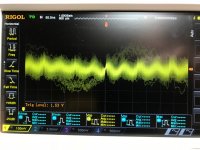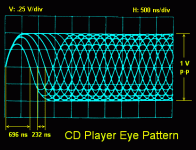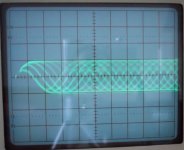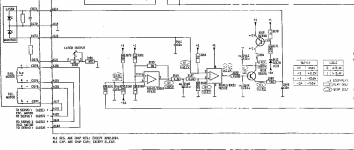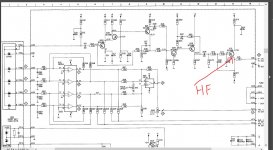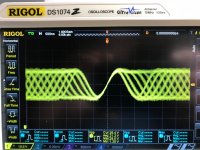Hello,
I have an Meridian MCD-101 CD Player which has intermittent disc reading problems.
Initially it would not find focus/spin disc at all, later it would play fine few tracks then get stuck or stutter.
I have recapped the servo circuits and the PSU caps yet it is still having issues, this time it can't read first 2/3 tracks and then it plays fine. Someties the startup issues are still present.
I had a go at scoping the Eye Pattern from the pickup's output. I've never done it before and I wonder if someone could help me analysing my findings.
I'm attaching a photo from the scope (I used a Rigol 100Mhz digital scope)
Any help would be much appriciated.
I have an Meridian MCD-101 CD Player which has intermittent disc reading problems.
Initially it would not find focus/spin disc at all, later it would play fine few tracks then get stuck or stutter.
I have recapped the servo circuits and the PSU caps yet it is still having issues, this time it can't read first 2/3 tracks and then it plays fine. Someties the startup issues are still present.
I had a go at scoping the Eye Pattern from the pickup's output. I've never done it before and I wonder if someone could help me analysing my findings.
I'm attaching a photo from the scope (I used a Rigol 100Mhz digital scope)
Any help would be much appriciated.
Attachments
No, that's just from the Laser Diode which emits the light (and the Monitor Diode which keeps it emitting at the correct light O/P).
That looks pretty Philips-y so you'll be looking for a signal I think labelled HF.
It'll be sourced from a bank of 6 Receiving Diodes (A,B,C &D for the 'music' info and E & F for Tracking duties) probably a few inches above in your picture. It'll then go through some RF Amplification and it's at that point it can be resolved by a 'scope.
P.
Edit. There'll be no E & F Diodes if it's a 'swinging arm' Philips. There may be a 'Guard' Diode (I think I remember that's what they called it) so there would be a bank of 5 Diodes. Look for the O/P of all these and follow through to a point where 'HF' is mentioned.
Can you post the schematic?
That looks pretty Philips-y so you'll be looking for a signal I think labelled HF.
It'll be sourced from a bank of 6 Receiving Diodes (A,B,C &D for the 'music' info and E & F for Tracking duties) probably a few inches above in your picture. It'll then go through some RF Amplification and it's at that point it can be resolved by a 'scope.
P.
Edit. There'll be no E & F Diodes if it's a 'swinging arm' Philips. There may be a 'Guard' Diode (I think I remember that's what they called it) so there would be a bank of 5 Diodes. Look for the O/P of all these and follow through to a point where 'HF' is mentioned.
Can you post the schematic?
Last edited:
Thanks for all your advise, I managed to find the HF poin in the machine and test the patter.
I'm attaching a photograph of the pattern - its quite blurry and a bit jerky. The player plays great for 80% of the time but I still sometimes have startup issues, it seems like it is trying to read the table of contents but it can't quite find it/focus properly.
Any suggestions?
Regards,
Hubert
I'm attaching a photograph of the pattern - its quite blurry and a bit jerky. The player plays great for 80% of the time but I still sometimes have startup issues, it seems like it is trying to read the table of contents but it can't quite find it/focus properly.
Any suggestions?
Regards,
Hubert
Attachments
Just to add (sorry I could't find edit option to add it to my previous message) - The player will still output the same waveform when audibly the audio stutters or completely drops out during playback. The audio will go from silent to choppy(very even, almost thremolo like) and then back to playing in around 1 minute.
That looks basically OK to me. The amplitude should be around 1.2 volts peak to peak for most players.
It is very important to use the correct ground point for the probe which in this case would be the ground used by the components around the transistor you are measuring on.
It is very important to use the correct ground point for the probe which in this case would be the ground used by the components around the transistor you are measuring on.
Which discs does it struggle to play?
If it is a Philips Swinging arm Mech/Laser then it will almost certainly not have been designed to play CDR's etc.
Red Book only.
Can you 'scope the Eye Pattern in 'fault' mode?
P.
If it is a Philips Swinging arm Mech/Laser then it will almost certainly not have been designed to play CDR's etc.
Red Book only.
Can you 'scope the Eye Pattern in 'fault' mode?
P.
- Status
- Not open for further replies.
- Home
- Source & Line
- Digital Source
- Meridian MCD 101 Eye Pattern
